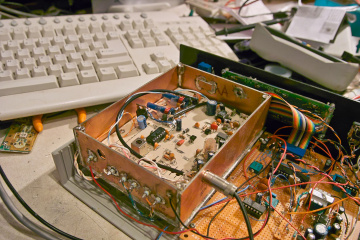How about higher-order
functions?
As noted, the Frequency/Temperature/Tuning voltage
relationships, when plotted out, describe a curve and not
a straight line. Because of this, a better
equation would be something like:
F = a2T + xT + b2V + yV + c
These would be able to better-accommodate the curve of
the tuning voltage and temperature effects on the Gunn
frequency - but there's a problem: This matrix
turns out to require double-precision floating point or
64-bit integer math in order to solve with any useful
degree of accuracy and doing either one would be a bit
of a hassle (but not impossible!) on an embedded
processor such as a PIC.
After realizing the difficulty with the above equation I
decided to try a straight-line approximation - and it
seemed to work out just fine for my purposes!
|




